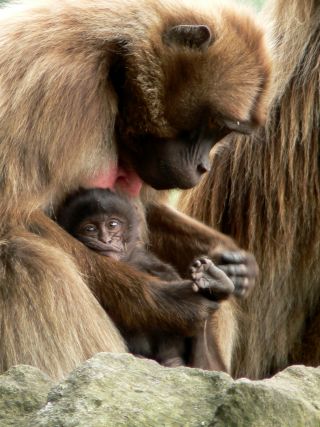Empathy
Monkey See, Monkey Smile
Rapid facial mimicry in gelada monkeys hints at evolution of empathy
Posted April 5, 2013

RFM during a play session between an adult (left) and a juvenile gelada (right). Credit: P.F. Ferrari
Don't be fooled by those impressive teeth. These two gelada monkeys (Theropithecus gelada) are making play faces at each other — the simian equivalent of sharing a laugh. It's an example of rapid facial mimicry (RFM), a quick and involuntary mirroring of another individual's facial expression. Previously, it had only been observed in humans and orangutans. A new study documents RFM in geladas, adding another primate species to the list of animals capable of this surprisingly sophisticated emotional exchange.
During RFM, individuals share more than just the same facial expression; they also share the emotions that go with it. People engage in RFM frequently, and it appears to be linked to the capacity to empathize with others. Human studies show the frequency of RFM is higher among friends and family than among unfamiliar individuals, and scientists theorize the behavior promotes emotional connections and social bonds between individuals.
Based on the importance RFM is thought to have in social interactions, Giada Mancini, Pier Francesco Ferrari, and Elisabetta Palagi examined whether geladas engage in it. Why geladas? They live in tight-knit social groups and spend a good deal of their time grooming one another and otherwise reinforcing social bonds. And captive geladas, like the ones observed in this study, engage in social play even as adults. During play sessions, geladas use facial displays to communicate their silly intentions and fine-tune their interactions. Mancini and colleagues describe these as the play face (in which the mouth is open with only the lower teeth exposed) and the full play face (in which the lips are pulled back to expose both the lower and upper teeth and gums). Like a person smiling and laughing when kidding around with a friend, these faces communicate playful intent and prevent misunderstandings in social situations.

Mother and infant gelada. Credit: Elisabetta Palagi
The researchers found geladas of all ages, from infants to adults, exhibit RFM during play. What's more, the highest frequency of RFM and the fastest response times were seen in interactions between mothers and their infants. In humans and other primates, the mother-infant bond is extremely important. RFM in human mothers and their babies is critical for the infant's neurophysiological and social development as well as the attachment relationship with the mother. Mancini and colleagues suggest the evolutionary origins of RFM may stem from early mother-infant relationships in our primate relatives.
This study only demonstrates the phenomenon of RFM exists in geladas; further research is needed to determine if the monkeys are sharing emotional states in addition to facial expressions. But observing RFM in a non-ape species is an important first clue to the evolution of social attachments and empathy in humans.
Reference:
Mancini, G., Ferrari, P.F. and Palagi, E. 2013. Rapid facial mimicry in geladas. Scientific Reports 3, Article number:1527. doi: 10.1038/srep01527


